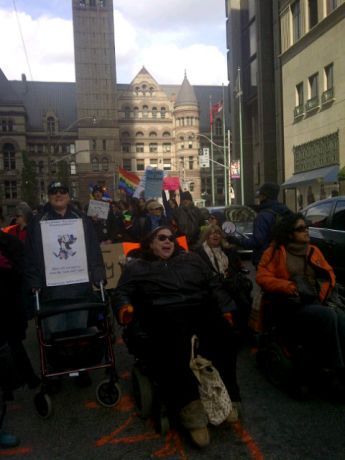Features
You are here
The disability movement

May 22, 2012
For people with disabilities, the struggle to be heard is still an uphill battle as we struggle to define ourselves as the movement. In some ways we can relate well to the history of the women’s movement. We have an international day of recognition, we struggle for gains politically, economically, and socially, but still many question if there is such a movement, or why one should exist in the first place.
Many of us living with disabilities see the need for activism and change. We’ve moved a long way from our history of raising our voices. Many organizations that were once active advocates for people with disabilities are now relying on government legislation to provide funding scraps. While there are individual activists rising to the challenge, the movement is still divided by disabilities and class. As a result, the rich and active history of people with disabilities who chained themselves to buses and started their own organizations has gotten lost. The movement will need to draw from history in order to make further progress.
There is hope: in 2011 new voices and issues were thrust into the spotlight, leading to revolution—and solidarity—in many parts of the world. Activists have changed the conversation to the point that Time magazine’s person of the year for 2011 was “The Protester.” People with disabilities have been a part of this change, and many are not content to sit back and wait—they are fighting for their rights, increasing the visibility of the movement with a kind of radical activism that seems to be growing.
In Montreal, an organization called Défense et revendication des droits des personnes en situation de handicap—Defending the Rights Of People With Disabilities (RAPLIQ), has been working for the elimination of discrimination faced by people with disabilities. In response to the lack of accessible transportation in the city, they called on people with disabilities to fill city hall—and they did.
In Toronto, close to 100 people with disabilities and their allies gathered at Nathan Philips Square in response to proposed cuts and the cancellation of the city’s annual International Day of Persons with Disabilities celebration. They took to the streets and marched down Bay Street to the site of Occupy Toronto chanting: “Equal Access, Equal Rights,” “Build Ramps Not Bombs,” “No Cuts! No Way! Tell Rob Ford we’re here to stay!” The march received a positive public response: truck drivers honked in solidarity as the group marched by, and a crew of construction workers paused to applaud.
So, what’s next for radical disability activism? The best thing we can do right now is build connections and learn more about what’s happening across Canada; reach out to people with disabilities that we see doing activist work, and connect them with related struggles. We also need to encourage each other to continue the work that we are doing. As the summer of 2012 approaches, let’s continue to build that solidarity with students, labour, and other movements, so that together we can build a better—and more accessible—world for all.
Section:
- Log in to post comments










